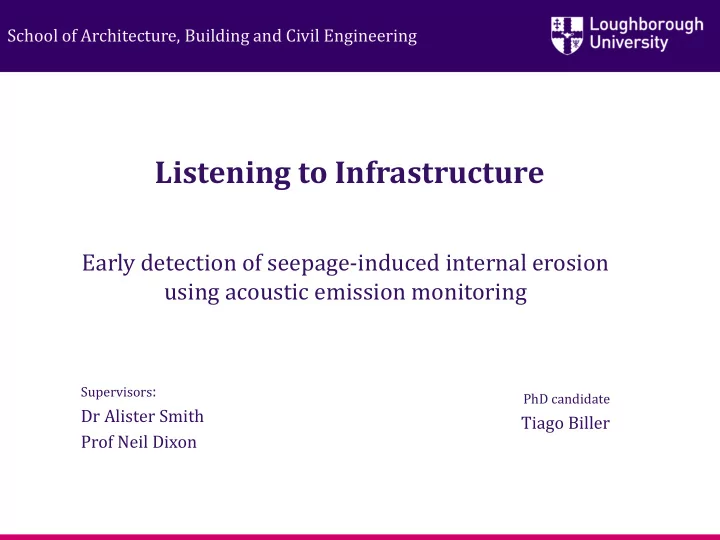

School of Architecture, Building and Civil Engineering Listening to Infrastructure Early detection of seepage-induced internal erosion using acoustic emission monitoring Supervisors : PhD candidate Dr Alister Smith Tiago Biller Prof Neil Dixon
Motivation 93m high earth zoned embankment Teton Dam. Idaho, USA (ICOLD, 2014) Morning of June 5 th , 1976: leak from right abutment. I. Silt with some clay, sand and gravel II. Selected sand, gravel end cobbles III. Miscellaneous fill IV. Selected, silt, sand, gravel and cobbles V. Rock fill Tiago Biller - t.biller@lboro.ac.uk School of Architecture, Building and Civil Engineering 1
Motivation (ICOLD, 2014) Mid-day: further enlarged and widened leak under crest Mid-morning: leak had enlarged upwards through the dam • 14 deaths • Up to US$1 billion property damage Tiago Biller - t.biller@lboro.ac.uk School of Architecture, Building and Civil Engineering 2
Seepage-induced internal erosion Goal: the detection internal erosion in its early stages, before serious damage has occurred Suffusion Suffosion Fannin and Slangen, 2014 Current monitoring techniques still do not offer viable early warning systems for seepage-induced internal erosion. Tiago Biller - t.biller@lboro.ac.uk School of Architecture, Building and Civil Engineering 3
Acoustic emissions and internal erosion Koerner et al. (1981) Tiago Biller - t.biller@lboro.ac.uk School of Architecture, Building and Civil Engineering 4
Experimental setting Permeameter Operation: - Flow is induced by applying a constant hydraulic head - Pressure is measured by manometers and pressure transducers at two different heights along the specimen - Water flow and eventual particle movement generate AE - AE is transmitted through a waveguide and measured by a sensor external to the specimen - The signal is amplified, pre-filtered by a data acquisition software and stored for further analysis Tiago Biller - t.biller@lboro.ac.uk School of Architecture, Building and Civil Engineering 5
Data processing and interpretation Characterization of tested material Internal stability criterion – Burenkova (1993) Tiago Biller - t.biller@lboro.ac.uk School of Architecture, Building and Civil Engineering 6
Data processing and interpretation Hydraulic gradient and counts of filtered AE events Amplitude ratio of signal in different frequencies 7
Project structure Tiago Biller - t.biller@lboro.ac.uk School of Architecture, Building and Civil Engineering 8
Future developments Testing equipment Planned apparatus improvements: • Mechanism for varying effective stress • Measurement of specimen deformation (LVDT) • Mass loss quantification (sediment trap, turbidity sensor) • Capacity to control specimen spatial orientation • Sensor choice (Hydrophones?) Scale modelling Scaled mock-ups of earth dams and levees are to be used for testing phenomena like erosion progression and structural collapse in relation to AE. Field trials Ongoing collaboration with stakeholders gives the opportunity to apply and evaluate the knowledge from laboratory experiments in the field environment. Tiago Biller - t.biller@lboro.ac.uk School of Architecture, Building and Civil Engineering 9
10 (after Moffat and Fannin, 2011) (after Skempton and Brogan, 1994) Equipment design
Thank you! Tiago Biller t.biller@lboro.ac.uk Inspiring Winners Since 1909
Robb et al. (2006) Koerner et al. (1981) Li and Fannin, 2012
(ICOLD, 2014) Teton Dam site at present - dam has not been rebuilt. flow net through idealized earth dam. Top: dam with a drainage blanket (no core) (modified after Encyclopædia Brittanica, 1999). Bottom: flow net parts: phreatic line separates saturated and unsaturated zones; blue arrows: flow direction; each field is delimited by the intersection of equipotential and flow lines.. Nd=number of potential drops; Nf=total number of flow channels (after Cedergren, 1989) Modified hydromechanical envelope model by Ferdos et al. (2018). Change of in-situ principal stresses in porous media under hydraulic loading and fluid seepage; the undisturbed Mohr-Coulomb circle (black line) shifts to the left due to the hydraulic loading (blue line) and upward due to seepage flow (double blue line). τ 1 and τ 2 are the maximum Internal instability of a soil based on its grading shear stresses that the specimen can take before instability occurs, τ b1 and τ b2 are the total (H/F min ratio) and critical hydraulic gradients (i c ), induced shear stress on the specimen and τ fn is the flow-induced shear stress. including the effect of two different flow orientations (after Skempton and Brogan, 1994).
Recommend
More recommend